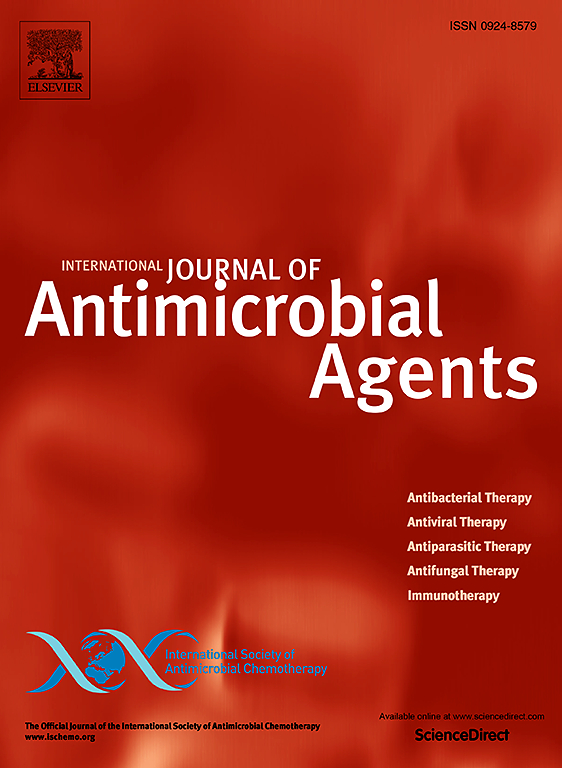Unravelling AMR dynamics in the rumenofaecobiome: Insights, challenges and implications for One Health
IF 4.9
2区 医学
Q1 INFECTIOUS DISEASES
International Journal of Antimicrobial Agents
Pub Date : 2025-03-21
DOI:10.1016/j.ijantimicag.2025.107494
引用次数: 0
Abstract
Antimicrobial resistance (AMR) is a critical global threat to human, animal and environmental health, exacerbated by horizontal gene transfer (HGT) via mobile genetic elements. This poses significant challenges that have a negative impact on the sustainability of the One Health approach, hindering its long-term viability and effectiveness in addressing the interconnectedness of global health. Recent studies on livestock animals, specifically ruminants, indicate that culturable ruminal bacteria harbour AMR genes with the potential for HGT. However, these studies have focused predominantly on using the faecobiome as a proxy to the rumen microbiome or using easily isolated and culturable bacteria, overlooking the unculturable population. These unculturable microbial groups could have a profound influence on the rumen resistome and AMR dynamics within livestock ecosystems, potentially holding critical insights for advanced understanding of AMR in One Health. In order to address this gap, this review of current research on the burden of AMR in livestock was undertaken, and it is proposed that combined study of the rumen microbiome and faecobiome, termed the ‘rumenofaecobiome’, should be performed to enhance understanding of the risks of AMR in ruminant livestock. This review discusses the complexities of the rumen microbiome and the risks of AMR transmission in this microbiome in a One Health context. AMR transmission dynamics and methodologies for assessing the risks of AMR in livestock are summarized, and future considerations for researching the impact of AMR in the rumen microbiome and the implications within the One Health framework are discussed.

解开瘤胃微生物组的AMR动力学:对同一健康的见解,挑战和影响。
抗菌素耐药性(AMR)是对人类、动物和环境健康的重大全球性威胁,通过移动遗传元件(MGEs)进行的水平基因转移(HGT)加剧了这一威胁。这构成了重大挑战,对“同一个健康”办法的可持续性产生负面影响,阻碍了其在解决全球卫生相互联系方面的长期可行性和有效性。最近对家畜特别是反刍动物的研究表明,可培养的瘤胃细菌中含有AMR基因(ARGs),具有HGT的潜力。然而,这些研究主要集中在使用粪便组作为瘤胃微生物组的代表,或使用易于分离和培养的细菌,忽略了不可培养的群体。这些不可培养的微生物群可能会深刻影响牲畜生态系统中的瘤胃抵抗组和抗菌素耐药性动态,可能为在同一健康中深入了解抗菌素耐药性提供关键见解。为了解决这一差距,我们回顾了目前关于家畜抗菌素耐药性负担的研究,并提出了将瘤胃微生物组和粪便组(称为rumenofaecobiome)相结合的研究,以增强我们对反刍家畜抗菌素耐药性风险的理解。我们讨论了瘤胃微生物组的复杂性和在一个健康背景下这种微生物组中AMR传播的风险。我们总结了抗菌素耐药性的传播动态,评估牲畜抗菌素耐药性风险的方法,并评论了未来研究抗菌素耐药性对瘤胃微生物组的影响的考虑因素以及在同一个健康框架内的影响。
本文章由计算机程序翻译,如有差异,请以英文原文为准。
求助全文
约1分钟内获得全文
求助全文
来源期刊
CiteScore
21.60
自引率
0.90%
发文量
176
审稿时长
36 days
期刊介绍:
The International Journal of Antimicrobial Agents is a peer-reviewed publication offering comprehensive and current reference information on the physical, pharmacological, in vitro, and clinical properties of individual antimicrobial agents, covering antiviral, antiparasitic, antibacterial, and antifungal agents. The journal not only communicates new trends and developments through authoritative review articles but also addresses the critical issue of antimicrobial resistance, both in hospital and community settings. Published content includes solicited reviews by leading experts and high-quality original research papers in the specified fields.

 求助内容:
求助内容: 应助结果提醒方式:
应助结果提醒方式:


